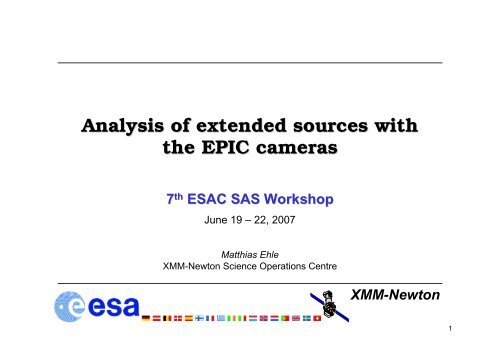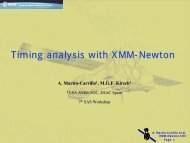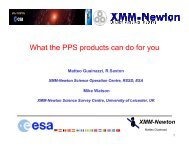Analysis of extended sources with the EPIC cameras - XMM-Newton
Analysis of extended sources with the EPIC cameras - XMM-Newton
Analysis of extended sources with the EPIC cameras - XMM-Newton
You also want an ePaper? Increase the reach of your titles
YUMPU automatically turns print PDFs into web optimized ePapers that Google loves.
<strong>Analysis</strong> <strong>of</strong> <strong>extended</strong> <strong>sources</strong> <strong>with</strong><strong>the</strong> <strong>EPIC</strong> <strong>cameras</strong>7 th ESAC SAS WorkshopJune 19 – 22, 2007Matthias Ehle<strong>XMM</strong>-<strong>Newton</strong> Science Operations Centre<strong>XMM</strong>-<strong>Newton</strong>1
Status• <strong>Analysis</strong> <strong>of</strong> <strong>extended</strong> <strong>sources</strong> is complex, challenging and time-consuming• There is currently nei<strong>the</strong>r an “<strong>of</strong>ficial” SAS recipe, nor a simple thread• Some tasks cannot be accomplished <strong>with</strong> SAS. They require FTOOLS or homemades<strong>of</strong>tware; Several groups were/are independently working in this field…• But (since 2005) <strong>XMM</strong>-<strong>Newton</strong> <strong>EPIC</strong> Background working group (BGWG):“A steering and supervising committee to provide <strong>the</strong> user <strong>with</strong> clear informationon <strong>the</strong> <strong>EPIC</strong> Background and (SAS)-Tools to treat <strong>the</strong> <strong>EPIC</strong> Background correctlyfor various TBD scenarios”http://xmm.esac.esa.int/external/xmm_sw_cal/background/ (also info on RGS/OM bkg.)– A table summarizing <strong>the</strong> temporal, spectral and spatial properties <strong>of</strong> <strong>EPIC</strong>background components– Progress & Meetings <strong>of</strong> <strong>the</strong> <strong>XMM</strong>-<strong>Newton</strong> <strong>EPIC</strong> Background working group– Products• <strong>XMM</strong>-<strong>Newton</strong> Extended Source <strong>Analysis</strong> S<strong>of</strong>tware package, ESAS• <strong>XMM</strong>-<strong>Newton</strong> 'blank sky' background files & related s<strong>of</strong>tware• Filter wheel closed data• O<strong>the</strong>r scripts• Links to related papers<strong>XMM</strong>-<strong>Newton</strong>Matthias Ehle2
Why?• Diagnostics <strong>of</strong> interstellar matter via SNR• Diffuse emission in nearby galaxies (halos, starburst winds)and groups <strong>of</strong> galaxies• Study <strong>of</strong> astrophysical jets (proto-stars, active galacticnuclei)• Temperature and metallicity pr<strong>of</strong>iles in clusters <strong>of</strong> galaxies...• ... is my favourite source <strong>extended</strong> or not?<strong>XMM</strong>-<strong>Newton</strong>Matthias Ehle3
Why is it so difficult? <strong>XMM</strong>-<strong>Newton</strong>Matthias Ehle4
Why is it so difficult (again)?<strong>XMM</strong>-<strong>Newton</strong>Matthias Ehle5
Which background to use (I)?• Often no statistically useful background region in <strong>the</strong> observationfield-<strong>of</strong>-view use “blank sky fields” to generate backgroundspectra• Recommended option (files produced for BGWG by Read & Carter, Uni. Leicester):http://xmm.esac.esa.int/external/xmm_sw_cal/background/blank_sky.shtml– a superposition <strong>of</strong> many (~200) pointed observations <strong>of</strong> pipelineproduct data from <strong>the</strong> 2<strong>XMM</strong> reprocessing– background event files (spectral) & exposure maps (spatial analysis):• MOS1 & MOS2: full-frame mode• PN: full-frame & <strong>extended</strong> full frame mode• Each filter mode combination event file available (thin, medium or thick)• twelve different instrument-filter-mode combinations• For each event list: two types <strong>of</strong> exposure map; vignetted and nonvignetted• two types <strong>of</strong> background event lists: unfilled & refilled<strong>XMM</strong>-<strong>Newton</strong>Matthias Ehle6
Using <strong>the</strong> blank sky field background• On <strong>the</strong> left is shown an image created from a pn events file <strong>with</strong> <strong>sources</strong> removed,and on <strong>the</strong> right, <strong>the</strong> image <strong>of</strong> <strong>the</strong> events file after <strong>the</strong> event filling procedure• Blank-Sky Fields exist as event lists, <strong>with</strong> DET[XY] column only<strong>XMM</strong>-<strong>Newton</strong>Matthias Ehle7
Using <strong>the</strong> blank sky field background (cntd(cntd.)S<strong>of</strong>tware available related to background files (shell scripts calling SAS/FTOOLS):– Skycast: to cast an <strong>EPIC</strong> background dataset onto <strong>the</strong> sky, at <strong>the</strong> position given by aninput template event dataset (e.g. <strong>the</strong> event file you are interested in producing abackground for); attcalc– BGrebinimage2SKY_2006: to re-bin and re-project exposure maps onto <strong>the</strong> sky to <strong>the</strong>spatial scale and sky position <strong>of</strong> a user-input image.– SelectRADec: to select events from a certain area <strong>of</strong> <strong>the</strong> sky, specifying a rightascension and declination (J2000), and <strong>the</strong> maximum distance from this position oneis prepared to consider. A final event file and exposure map is produced.Caveats: Variations in spectra…1. … <strong>with</strong> count rate &2. … over <strong>the</strong> sky:Note <strong>the</strong> higher count rate <strong>of</strong> <strong>the</strong> galacticcentre due to higher levels <strong>of</strong> s<strong>of</strong>t X-ray emissionGalactic CentreGalactic Anti-centreNorth Galactic PoleSouth Galactic Pole<strong>XMM</strong>-<strong>Newton</strong>Matthias Ehle8
Background re-normalization• You need to normalize <strong>the</strong> blank-skyfield background to <strong>the</strong> quiescent levelobserved during your observationWhat do you do if yourobservation falls here?• for example, 40 ksec <strong>of</strong> cleaned data• in Blank-sky: exposure time = 2245ksec ratio = 56.1 (or use o<strong>the</strong>r, moresophisticated scaling methods…)• divide <strong>the</strong> BS-extracted image by56.1 and subtract <strong>the</strong> resultant imagefrom <strong>the</strong> original users image• Similar scaling for BS backgroundspectra<strong>XMM</strong>-<strong>Newton</strong>Matthias Ehle9
Which background to use (II)?• Alternative approach use “model” to generate background spectra• Recommended option: (tool produced for BGWG by Snowden & Kuntz, US GOF):<strong>XMM</strong>-ESAS: Extended Source <strong>Analysis</strong> S<strong>of</strong>tware packagehttp://xmm.esac.esa.int/external/xmm_sw_cal/background/epic_esas.shtml– Allows to model quiescent particle background both spectrally & spatially forMOS detectors (support for pn is planned)– Produces background spectra for user-defined regions <strong>of</strong> <strong>the</strong> detectors andbackground images.– Output files are FITS standard & can be used in spectral fitting packages (e.g.,Xspec) or <strong>with</strong> FITS image display s<strong>of</strong>tware (e.g., fv or ds9).– <strong>XMM</strong>-ESAS is based on <strong>the</strong> s<strong>of</strong>tware used for <strong>the</strong> background modelingdescribed in Snowden, Collier & Kuntz (2004, ApJ, 610, 1182).– Package currently consists <strong>of</strong> both PERL scripts (calling SAS tasks) & standaloneFortran 77 programs. Goal: transform into proper SAS meta-task.<strong>XMM</strong>-<strong>Newton</strong>Matthias Ehle10
Background flare removal: <strong>the</strong> ESAS way• Instead <strong>of</strong> GTIs from count-rate limits > 10 keV - <strong>XMM</strong>-ESAS: filtering in user def. bandFilter limitsGaussian FitHigh count rate excursions due to s<strong>of</strong>t protons ra<strong>the</strong>r thanhigher-energy particles (which would produce increase in cornerdata)SAS task “espfilt” is under development…Strong s<strong>of</strong>t proton flaring data not useful for study <strong>of</strong>diffuse emission; 2 ks left are likely to be stillcontaminated<strong>XMM</strong>-<strong>Newton</strong>Matthias Ehle11
Which background to use (II)?• Method: corner pixels are a measure <strong>of</strong> <strong>the</strong> particle background• Use as many known parametersas possible ra<strong>the</strong>r than relying onlocal bkg determinations and blankskybackground data sets• E.g., use FWC data, RASS, s<strong>of</strong>tproton distribution, archivedobservation data sets<strong>XMM</strong>-<strong>Newton</strong>Matthias Ehle12
Which background to use (II)?• Model <strong>the</strong> Quiescent Particle Background (QPB) (after removal <strong>of</strong>flaring background)• Determine <strong>the</strong> corner spectral parameters: high-energy power law slope [2.4-12.0keV] and hardness ratio [(2.5-5.0)/(0.4-0.8)] from <strong>the</strong> observation data set<strong>XMM</strong>-<strong>Newton</strong>Matthias Ehle13
Which background to use (II)?• Quiescent Particle Background (QPB)Mean QPB spectrum derived from unexposed corner pixel data from all public screeneddata (~76 Msec for each camera). MOS1 black, MOS2 blue.Red lines: two regions used to measure hardness ratio (HR)Green line: fitted power law above 2.4 keVHR & slope used for parameterization <strong>of</strong> QPB; Prominent background lines are labeled.Both continuum and line contributions are both position and temporally varying<strong>XMM</strong>-<strong>Newton</strong>Matthias Ehle14
Which background to use (II)?• Model <strong>the</strong> Quiescent Particle Background (QPB) (after removal <strong>of</strong>flaring background)• Determine <strong>the</strong> corner spectral parameters: high-energy power law slope [2.4-12.0keV] and hardness ratio [(2.5-5.0)/(0.4-0.8)] from <strong>the</strong> observation data set• Search an archived-observation data base for observations <strong>with</strong> similar parameters• Augment <strong>the</strong> observation data set corner spectra <strong>with</strong> data from <strong>the</strong> archivedobservationdata base• Scale <strong>the</strong> Filter Wheel Closed (FWC) spectra (treat each CCD separately) for <strong>the</strong>region <strong>of</strong> interest by <strong>the</strong> ratio <strong>of</strong> <strong>the</strong> augmented observation corner spectra to <strong>the</strong>FWC corner spectra• Combine augmented & corrected corner-region spectra from different CCDs,correctly weighted, to form single bkg spectrum for object region<strong>XMM</strong>-<strong>Newton</strong>Matthias Ehle15
Addition: Filter wheel closed data• Filter wheel closed (FWC) data– from calibration obs. <strong>with</strong> filter wheel in closed position– Released in September 2006: stacked collections <strong>of</strong> FWC dataavailable for MOS and pn• What for?– closed position blocking X-rays & s<strong>of</strong>t protons from outside– Cosmic rays, however, still penetrate to <strong>the</strong> detectors allows clean measure <strong>of</strong> following (internal) bkg components:• high energy particles producing charge directly in CCDs• particle induced X-rays (continuum and fluorescent lines), generatedinside <strong>the</strong> camera• electronic readout noise (at lowest energies)• Components are distributed non-homogeneously!• BGWG provides <strong>the</strong>m for MOS & PN, different filters & modes…<strong>XMM</strong>-<strong>Newton</strong>Matthias Ehle16
Filter Wheel Closed Data: MOS• MOS FWC Data: spectral & spatial propertiesVery strong Al K & Si K fluorescentinstrumental lines ( 1.49 keV and 1.75 keV)on top <strong>of</strong> continuum. O<strong>the</strong>r fluorescent lines athigher energies; strong low-energy tail due todetector noise<strong>XMM</strong>-<strong>Newton</strong>Matthias Ehle17
Filter Wheel Closed Data: PN• PN FWC data: spectral & spatial properties<strong>XMM</strong>-<strong>Newton</strong>Matthias Ehle18
Using <strong>the</strong> Extended Source <strong>Analysis</strong> S<strong>of</strong>tware• <strong>XMM</strong>-ESAS comes toge<strong>the</strong>r <strong>with</strong> detailed Users manual, supporting calibration files,& example data set (covering spectral & imaging aspects; Galaxy Cluster A 1795)• Model uses data from unexposed (to <strong>the</strong> sky) corners <strong>of</strong> MOS detector (alsoarchived), filter-wheel-closed data, ROSAT All-Sky Survey data• Avoids use <strong>of</strong> blank-sky data: include to an un-known level contributions <strong>of</strong> cosmicbackground, residual s<strong>of</strong>t proton contamination, & solar wind charge exchangecontamination.Results <strong>of</strong> ESAS & blank-sky methodsin good agreement (uncertainties atlarge annuli smaller using <strong>the</strong><strong>XMM</strong>-ESAS method).Discrepancy between <strong>XMM</strong>-<strong>Newton</strong> &Chandra (Vikhlinin et al., 2005) is beingstudied..Temperature Pr<strong>of</strong>ile A 1795<strong>XMM</strong>-<strong>Newton</strong>Matthias Ehle19
Spectral analysis• Some results from <strong>XMM</strong>-ESAS (Abell 1795):Observed spectrumModel particle bkg.Model bkg. subtractedBridge where fluorescentlines affect <strong>the</strong> data (notmodeled)Filter wheel closedspectrum: strongfluorescent lines on top <strong>of</strong>continuum, low energy taildue to detector noiseDiscrepancydue to residuals<strong>of</strong>t protoncontaminationFitted MOS1 &MOS2 spectrabkg. NOT subtracted<strong>XMM</strong>-<strong>Newton</strong>Matthias Ehle20
Xspectricks• Add RASS (Rosat All Sky Survey) data <strong>of</strong> your source to constraint s<strong>of</strong>t(< 2.4 keV) part– see ESAS & HEASARC X-Ray Background Tool athttp://heasarc.gsfc.nasa.gov/cgi-bin/Tools/xraybg/xraybg.pl• Variable Al (1.49 keV) & Si (1.75 keV) fluorescent instrumental lines:ignore this energy range (ESAS) and model <strong>the</strong>m in Xspec• Aim at linking or freezing as many as possible fit parameters (seeESAS cookbook):• Cluster model: bknpow/b + gauss + gauss + con*con*Res. s<strong>of</strong>t proton bkg. Al-1.49keV Si-1.75keV MOS1&2 solid angleCosmic bkg.(apec + (apec + apec + pow)*wabs +LHB-0.1keV cool halo-0.1keV hot halo-0.25keV unres.bkg.apec*wabs)cluster emission<strong>XMM</strong>-<strong>Newton</strong>Matthias Ehle21
Image smoothingIn Principle: asmooth inset=unsmoo<strong>the</strong>d.img outset=smoo<strong>the</strong>d.img sigma=2.5smoothstyle=simple convolversttyle=gaussian(smoothstyle=adaptive available as well)Or use adapt-900 from <strong>the</strong> <strong>XMM</strong>-ESAS package: adaptive smoothing <strong>of</strong> backgroundsubtracted & exposure corrected images (can merge MOS1 & MOS2)Abell 1795 (0.35-1.25 keV) observed counts & bkg-subtracted & exp. corrected, smoo<strong>the</strong>d image<strong>XMM</strong>-<strong>Newton</strong>Matthias Ehle22
Fur<strong>the</strong>r scripts: Fin/FoutFout• Estimation <strong>of</strong> <strong>the</strong> residual S<strong>of</strong>t Proton (SP) flare contamination– shell script to perform <strong>the</strong> Fin/Fout ratio calculation– Method described in Molendi et al. (2004, A&A 419, 837)– Runs on <strong>EPIC</strong> event files (MOS1, MOS2 and/or pn), to estimateamount <strong>of</strong> residual SP flare contamination (after attempts havebeen made to clean <strong>the</strong> event files using GTI filtering)• Script compares area-corrected count rates in <strong>the</strong> in-FOV (beyond10 arcminutes) and out-<strong>of</strong>-FOV regions <strong>of</strong> <strong>the</strong> detector. The higher<strong>the</strong> in-FOV to out-<strong>of</strong>-FOV ratio, <strong>the</strong> more <strong>the</strong> file is contaminatedby SPs:– Ratio < 1.15 : File is not contaminated by SPs.– Ratio 1.15-1.3 : File is slightly contaminated by SPs.– Ratio 1.3-1.5 : File is very contaminated by SPs.– Ratio > 1.5 : File is extremely contaminated by SPs.• Not suited for <strong>extended</strong> <strong>sources</strong> filling <strong>the</strong> entire field <strong>of</strong> view<strong>XMM</strong>-<strong>Newton</strong>Matthias Ehle23






